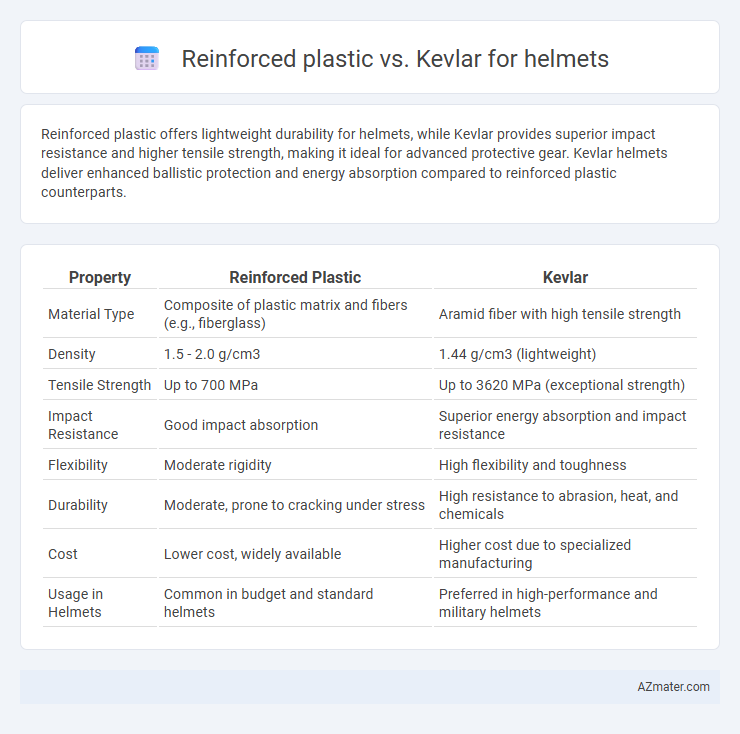Reinforced plastic offers lightweight durability for helmets, while Kevlar provides superior impact resistance and higher tensile strength, making it ideal for advanced protective gear. Kevlar helmets deliver enhanced ballistic protection and energy absorption compared to reinforced plastic counterparts.
Table of Comparison
| Property | Reinforced Plastic | Kevlar |
|---|---|---|
| Material Type | Composite of plastic matrix and fibers (e.g., fiberglass) | Aramid fiber with high tensile strength |
| Density | 1.5 - 2.0 g/cm3 | 1.44 g/cm3 (lightweight) |
| Tensile Strength | Up to 700 MPa | Up to 3620 MPa (exceptional strength) |
| Impact Resistance | Good impact absorption | Superior energy absorption and impact resistance |
| Flexibility | Moderate rigidity | High flexibility and toughness |
| Durability | Moderate, prone to cracking under stress | High resistance to abrasion, heat, and chemicals |
| Cost | Lower cost, widely available | Higher cost due to specialized manufacturing |
| Usage in Helmets | Common in budget and standard helmets | Preferred in high-performance and military helmets |
Introduction to Helmet Materials: Reinforced Plastic vs Kevlar
Reinforced plastic helmets utilize composite materials such as fiberglass or carbon fiber combined with resins, offering a lightweight yet durable protection ideal for impact resistance. Kevlar helmets incorporate aramid fibers known for exceptional tensile strength and resistance to penetration, providing superior ballistic protection and resilience against high-velocity impacts. Both materials are engineered to optimize safety, but Kevlar generally excels in combat and law enforcement applications, while reinforced plastics are common in sports and industrial helmets.
Structural Properties: Strength and Durability Comparison
Reinforced plastic helmets, typically made from fiberglass or carbon fiber composites, offer excellent tensile strength and impact resistance but may exhibit lower durability under repeated stress compared to Kevlar. Kevlar helmets provide superior tensile strength combined with exceptional energy absorption and resistance to penetration, making them highly durable against ballistic impacts and long-term wear. The molecular structure of Kevlar fibers, characterized by strong intermolecular bonds and high modulus of elasticity, contributes to enhanced durability and structural integrity in demanding helmet applications.
Weight Differences: Impact on Comfort and Performance
Reinforced plastic helmets typically weigh more than Kevlar helmets, influencing overall comfort during extended wear by increasing neck strain and fatigue. Kevlar's lightweight properties enhance mobility and reduce user fatigue, which is critical for performance in high-speed or tactical scenarios. The weight advantage of Kevlar contributes to improved wearer endurance and agility, making it a preferred choice for professionals demanding optimal balance between protection and comfort.
Safety Standards: Certification and Crash Test Results
Reinforced plastic helmets typically meet industry safety standards such as DOT, ECE, and Snell certifications, providing reliable impact resistance and durability in crash tests. Kevlar helmets excel with superior energy absorption and penetration resistance, often achieving higher ratings in advanced testing protocols like SHARP and SNELL due to Kevlar's lightweight yet robust fiber composition. Crash tests consistently show Kevlar helmets deliver enhanced protection against high-velocity impacts and shrapnel penetration, making them a preferred choice for premium safety and performance in hazardous conditions.
Impact Resistance: Real-world Performance Analysis
Kevlar helmets exhibit superior impact resistance due to their high tensile strength and ability to absorb and dissipate energy upon impact, reducing force transmitted to the head. Reinforced plastic helmets offer good protection but tend to be more brittle under high-impact conditions, potentially leading to cracks or fractures. Real-world crash tests consistently demonstrate Kevlar's enhanced durability and resilience, making it a preferred material for high-performance protective gear.
Cost Considerations: Affordability and Value
Reinforced plastic helmets typically offer a lower upfront cost compared to Kevlar helmets, making them more affordable for budget-conscious consumers. Kevlar helmets provide superior impact resistance and durability, which can translate to longer lifespan and better protection, offering greater value over time despite higher initial expenses. Evaluating total cost of ownership, including durability and safety performance, is crucial when choosing between these helmet materials.
Flexibility and Design Adaptability
Reinforced plastic offers high flexibility and can be easily molded into complex helmet shapes, allowing designers to optimize aerodynamics and comfort. Kevlar, while providing exceptional impact resistance and lightweight strength, is less flexible during manufacturing, limiting intricate design adaptations. The combination of reinforced plastic with Kevlar layers enhances helmet durability while maintaining adaptable design flexibility.
Environmental Resistance: UV, Water, and Chemical Exposure
Kevlar offers superior environmental resistance compared to reinforced plastic, with excellent UV stability and minimal degradation under prolonged sunlight exposure. Its hydrophobic properties provide enhanced water resistance, preventing moisture absorption that can weaken the helmet structure. Chemically, Kevlar withstands a broad range of solvents and corrosive agents better than most reinforced plastics, ensuring greater durability and safety in harsh conditions.
Longevity and Maintenance Requirements
Reinforced plastic helmets offer durability with moderate maintenance, requiring regular inspections for cracks or wear to ensure longevity often spanning several years under typical use. Kevlar helmets provide superior impact resistance and greater longevity due to their high tensile strength and inherent resilience to environmental degradation, demanding less frequent maintenance. Both materials benefit from proper care, but Kevlar's advanced fiber composition results in longer service life and reduced upkeep compared to reinforced plastic options.
Conclusion: Choosing the Optimal Helmet Material
Reinforced plastic offers excellent impact resistance and cost-effectiveness, making it suitable for everyday helmets, while Kevlar excels in high-strength, lightweight protection ideal for extreme conditions. Kevlar's superior tensile strength and energy absorption capabilities provide enhanced safety for military and competitive sports applications. Selecting the optimal helmet material depends on specific use cases, balancing durability, weight, and budget to ensure maximum protection and performance.

Infographic: Reinforced plastic vs Kevlar for Helmet
 azmater.com
azmater.com